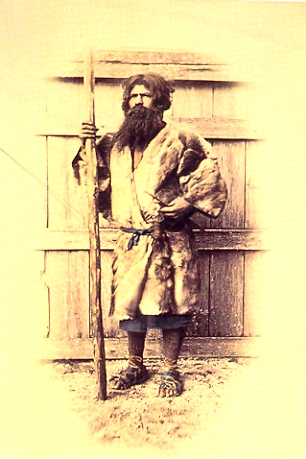
Posted on 12/08/2008 4:58:57 PM PST by BGHater
The Ainu are the indigenous people of Japan, inhabiting the Northern island of Hokkaido as well as the Kuril Islands and Sakhalin. Their name means “human”, or more accurately the opposite of the gods that inhabit all plants, objects, and animals in their heavily animistic religion.

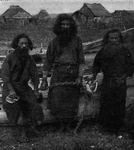
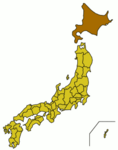

Thought to once inhabit all of Japan, the Ainu were pushed northward by the influx of immigration from Asia that occurred primarily during the Yayoi period of Japanese history around 2,300 years ago.
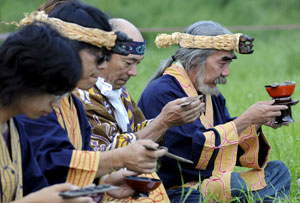
The Ainu have faced a long history of oppression and hardship. Throughout the modern era, they have faced active assimilation, forced labor, and the repression of their cultural identity and customs. During the height of the Japanese government’s assimilation policy in the 1800s, the Ainu were banned from observing daily customs and were labelled as “former aboriginal people,” and it was not until 1997 that they were even recognized as an indigenous minority group at all.
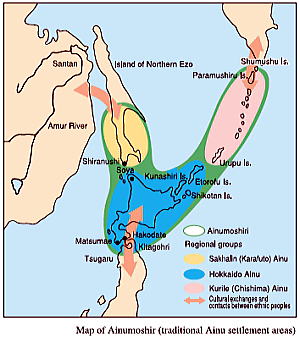
It is estimated that there are around 20,000 to 60,000 people (many of mixed race) who identify themselves as Ainu today, although the accuracy of these numbers is questionable due to the fact that for a long time Japanese census records made no distinction between Ainu and ethnic Japanese, as well as the tendency for many to hide their ancestry due to rampant discrimination in some areas. There could be as many as ten times more than that according to some.

Shown is an Ainu woman with a traditional lips tattoo. Almost all woman had these tattoos done upon reaching adulthood, which was 15 or 16 by Ainu standards. The tattoos are believed to increase beauty and gain better prospects for marriage, as well as being a sort of rite of passage into womanhood.
Besides the political controversy of the plight of the Ainu people, they have also raised other debates within anthropology and hominology. One such debate is that of the very origins and history of this people. Ainu are very different in physical appearance than ethnic Japanese and other Asian peoples. Taller than average Japanese, the Ainu typically have a long skull, light complexion, heavy facial hair, and Caucasian features. Their hair tends to be thick and wavy, and body hair is also more pronounced. Aside from the physical differences, the Ainu language is also quite unique, showing no relation to Japanese or other Asian languages. These unique differences have posed an often debated mystery. Who are the Ainu and where did they come from?


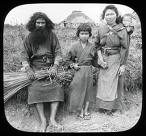
Early anthropologists were fascinated by the Ainu and made much of the physical differences that existed between Ainu and Japanese. These early researchers often exaggerated these physical qualities, and suggested that they were evidence of Caucasian ancestry. The Ainu were said to be a sort of “lost Caucasian race”. However, there is no genetic evidence of this and it is considered an outdated theory. The mystery remained however, since it was obvious that the Ainu people and ethnic Japanese were of different origins.
There are many current ideas on the origins of the Ainu people. Some suggest that the same prehistoric group of people that produced the Australian aborigines, a sort of “Oceania race,” also inhabited the Japanese archipelago before the Jomon period of Japan (14,000 to 2,500 years ago). This is based on fossils dating back 10,000 years that seem to show similarities with the indigenous people of Australia and New Zealand.
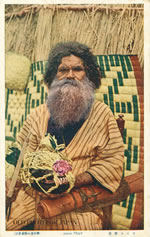
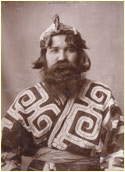


Others say that the Ainu are descendants of people of mongoloid stock from Northeast and central Asia, who migrated to Japan before the Jomon period. Genetic evidence seems to support this theory, since DNA tests on Ainu showed that many showed a relationship to the people of Tibet and the Adaman Islands of the Indian Ocean, and one in eight Ainu men were shown to exhibit genetic traits most common to the Russian far east and Mongolia.

There are other ideas too, such as that the Ainu represent a completely unique group of people, or an ancient Asian race, but the question of the exact origins of the Ainu remains unresolved.
The mystery of the Ainu does not end with their origins, however. One hotly debated topic that only adds to the mystery of Ainu history is the notion that they may have even been among the first peoples to inhabit North America. The epicenter of the debate swirling around this theory, and the best evidence for it, is a curious piece of fossil evidence called the Kennewick Man.
+++ Read part II on this contribution on Monday, “The Ainu and The Kennewick Man” by Brent Swancer, December 8, 2008.
The Ainu and the Kennewick Man -Part 2
The Kennewick Man, also sometimes referred to as the Richland Man, is a skeleton which was accidentally found at the Lake Wahulla section of the Columbia River in Kennewick, Washington on July 28, 1996. The skeleton was in remarkably good condition, missing only the sternum and some bones in the hands and feet.
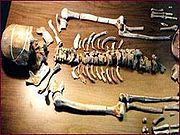
Upon examination, it was found that the skeleton lacked many distinctive features found in Native Americans, and exhibited some Caucasian features as well. In addition to features of the skull and bones, the condition of the teeth suggested a diet different from the Native Americans. For these reasons, it was thought that the remains were perhaps that of an early European explorer, however the mystery would only deepen upon further analysis.
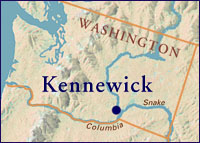
Through preliminary radio carbon dating, it was found that the remains were around 9,000 years old. Also, a projectile tip of a type used from around 8,500 BP to 4,500BP was found lodged in the hip. It seemed that this was no European explorer, but rather a stone age individual with characteristics unlike the later Native Americans. Anthropologists and paleontologists rushed in to do more detailed examinations and try to determine the nature of these mysterious remains. Upon comparing the remains to 18 modern populations of humans, it was determined that the ancestry most closely resembled that of the Ainu.

The study of the Kennewick Man remains has long been embroiled in controversy. The remains were originally taken possession of by the U.S. Army Corps of engineers, who own the land on which the remains were found, however this was immediately challenged in court by the NAGPRA (Native American Graves Protection and Repatriation Act). NAGPRA states that any human remains found on federal lands that are found to be affiliated with a Native tribe can be claimed by that tribe.
Several tribes claimed the remains as their own and demanded their return for a proper burial. This was quickly opposed by a group of archeologists and anthropologists who claimed that NAGPRA did not apply in this case. And so the long legal battles surrounding the Kennewick man started, often holding up studies and even bringing research on the remains to a halt. Examination was halted in 1996 due to court battles and debates with Native tribes, only to resume again in 1998.
Scientific studies that were done on the skeleton from 1998 to 2000 were frequently dogged by legal woes, and it wasn’t until 2002 that a federal court ruled that NAGPRA did not apply to the remains as a cultural link was not met, and this allowed scientists better access to the remains. This ruling was upheld again in 2004, but the firestorm of controversy and legal motions are far from over. Currently, the skeleton is being held at the Burke Museum at the University of Washington, and is legally designated as the property of the U.S. Army Corps of Engineers.
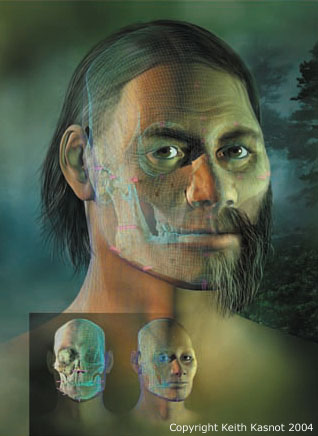
To date, despite the legal controversy, the Kennewick Man remains have been physically examined on various occasions using standard scientific methods and techniques, and some things have been gleaned from it. It is known that the man was between 45 and 55 years old, around 5′9″ in height, was muscular, and had received various injuries that appear to have healed before death. In addition, evidence suggests that the body was deliberately buried rather than left exposed to the elements. Yet the mystery of who this man was or where he came from remains as mysterious as ever. In 2006, results of studies performed on the remains in 2005 supported the earlier notion that these remains closely matched features found in the Ainu people.
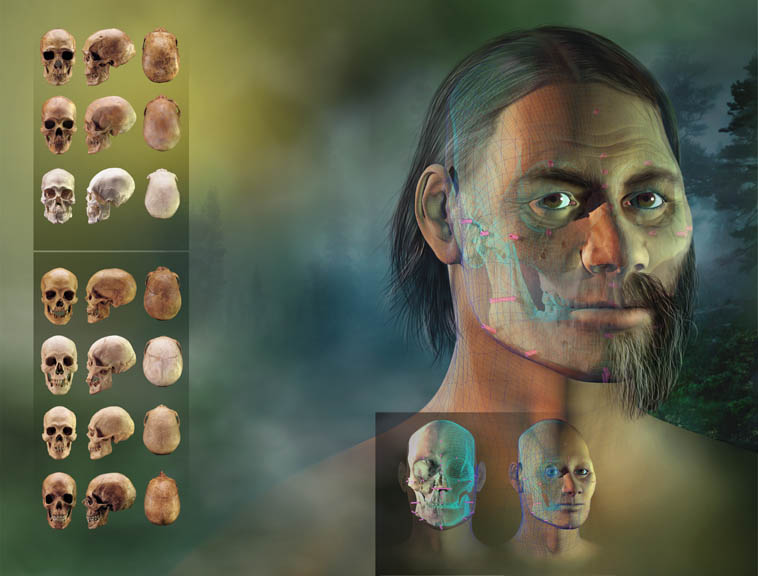
So is it possible that Ainu were some of the first humans to inhabit North America? The theory certainly has its share of detractors. Some insist that there are not enough samples to make any assumptions on the origins of the remains. They are quick to point out that the physical differences of a single specimen don’t mean anything in the larger picture and therefore the Kennewick Man is useless as evidence of anything. Others point to the greater physical diversity between individuals in remains dating over 8,000 years old, or even point to the blurry lines of race to begin with. It could be argued that human populations are not unambiguous or clearly separated biological groups so therefore any divisions made between biological populations are subjective and arbitrary, especially when looking at 9,000 years old bones.
The debate goes on, but the essential mystery remains. Who was Kennewick man? Further analysis of the remains may yield more answers, but if it is indeed the skeleton of an Ainu as speculated, then this would shake to the core our current conventional understanding of how and by whom the continent was first settled.
Footnote from Loren:
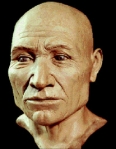
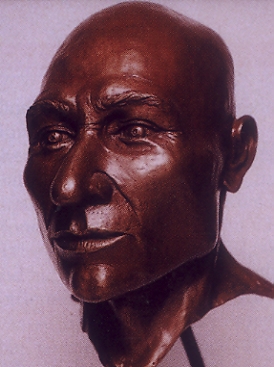
One of the first forensic reconstructions from the skull of the Kennewick Man looked extremely familiar to those who viewed it soon after its completion.

Very familiar.
Must have gotten boring, so during a short interlude between periods of maximum glaciation, probably around 35,000 years ago a bunch of 'em took off WEST and went to Europe. They were eventually driven back by a return of maximum glaciation and moved South into three refugia, one of which included the Pyrenees and the French/Spanish border area. All the Northern, Western and Eastern Europeans descend from that group which fanned out to the North, West and East as the glaciers retreated.
Another group resided in a Southern European refugia. All the people along the North shore of the Mediterranean and much of the Middle East descend from those people. There was a third refugee for European people in the Middle East.
There was another group residing in Kazakhstan that went EAST during another short interglacial. They divided into two different East Asian groups about 20,000 years ago. Up until that they they resembled the folks who moved West to Europe. However, when this division took place somewhere in the Himalayan Plateau, one group developed an extra root on the teeth in the upper jaw.
The other group didn't.
However, neither group was, technically speaking, "European". Even their genes for "white skin" are different than the European distant relatives, and none of them digest milk well as adults.
AFTER the ice withdrew the oceans rose. Before that the folks with the extra root on their teeth had spread out from Southern Siberia into the mountains of Japan. When the ocean rose with the melting of the North American glaciers, the people on the continent became separated from those on what became known as the Japanese islands.
Similarly, the other East Asian group (which doesn't have the extra root on teeth) Spread East and South into what is now China. It is supposed that during this period more Southerly people living in SE Asia moved North into China and mixed with both populations. (So those Australoid characteristics you sometimes see in Japanese and Chinese are not your imagination).
Anyway, the guys with the extra tooth root are known as the Ainu if they lived on the Asian mainland and Jomon if they lived on the Japanese home islands.
That takes us to about 10,000 BC.
From that point on it was one thing after the other and the Chinese developed an indigenous civilization or two and that created other problems. For one, it drove the Ainu OUT of the Yangtze and and Hwang Ho river valleys. They moved NORTH into Siberian coastal areas.
Their Jomon cousins in Japan lived as hunter gatherers, with only a minor amount of agricultural development until the Yayoi invaded from China about 500 BC-. They then withdrew to the North and became known as the Emeshi people, and they also developed civilization, including the use of iron, to defend against the Yayoi. They appear to have held on nicely until the arrival of the Imperial Family and the people who became the Daimyo circa 6th Century AD.
These guys had developed in Siberia, moved to Nepal, conquered India by about 500 BC, then, about 200 AD they got kicked out and returned to their Siberian homeland (Yakutia).
The Imperial Family/Daimyo group readily conquered the civilized Yayoi but it took them about 700 more years to fully conquer the Jomon/Emeshi. That was finally accomplished by hiring Emeshi as Samurai and turning the Imperial Samurai against the wild Samurai in the North.
Once all the Emeshi were conquered they were relocated to Fukuoka where they were used to beat up on all the other Japanese to keep the Imperial Family/Daimyo in power. That worked out pretty well until Perry arrived!
Modern dentists report that 40% of modern Japanese have teeth with the extra root!
The Ainu on the Northeast Asian coastal region took the opportunity in about the 1600s, while the Japanese were up to their eyeballs in European troublemakers, to invade Hokaido and other Northern regions.
Of much more interest are the Imperial Family/Daimyo ~ the traditional Japanese leadership elite.
These people came from Siberia, not Korea, nor from Tibet, like all the other groups. If you look up Sakha or Yakut you will find them. There are thousands of articles about them on the net, may in Russian. The ESKIMO groups descend from an early BC offshoot of this crowd. Some American Indian groups may share considerable ancestry with them ~ see Dene.
Their big event was their move from Siberia to India, and then their return from India to Siberia. Along the way they fathered Buddha. That journey took doggone near 1,000 years ~ do don't get the idea that just 'cause you live in America that your descendants aren't going to return to Europe or Africa.
The modern Sakha/Yakut have numerous individuals who look Caucasion ~ which is 'cause they are. At the same time they have many individuals who look terribly East Asian, and again, that's 'cause they are.
This body of people share a single culture of animal herding but they really do have two races. Obviously there've been intermarriages over the many hundreds of years they've lived in the same place, but they are not totally mixed as yet.
The Japanese Imperial Families are remarkably light skinned BTW, but because of a totally different gene set than Europeans.
Aren't the Athapascan Indians thought to descend from a later group of immigrants to the Western Hemisphere than other American Indian groups? (Navajo is an Athapascan language.)
Match the Shang characters to the signs.
Amazing, hunh?
And I bet somebody taught you the Chinese didn't get here, and that North American Indians (outside of Meso America) were "illiterate" with no written language.
Of course writing in the air doesn't count does it.
Eskimos came later, but went further. First people around the world were the Eskimos who start out with the Sakha/Yakut people. This same bunch right there as the Dark Ages began conquered the Korean peninsula and began a conquest of Japan.
There has been regular and continuing contact by sea with tribes on the periphery of Chinse civilization for thousands of years.
That went on a long time then they met the Americans who came around the world from the other direction.
Thanks for this amazing post — I had heard of Kennewick Man long ago (high school in the ‘90s, probably), but never knew of the connection to the Ainu.
My wife is Ainu, and while she has beautiful multicolored hair and lighter skin that most Japanese, she’s not the least bit interested in the language or traditional culture. (Her grandmother, the last to experience real Ainu life in a ‘kotan’ or village, died long ago.) So it’s up to me to study all this stuff. What a pleasant surprise it is to find more people who are interested in the Ainu.
Thanks and ‘iyayraykere’ again!
I believe the current Emperor has the extra roots in fact.
There may well have been contact between the Yakut and the Ainu in pre-end of Ice Age populations too. Folks are just now getting around to digging up the bones in China proper, although quite a bit has been done in Russian Siberia and Inner Mongolia right on back to the 1920s.
Now, the light hair syndrome ~ no doubt you've noticed there are folks with redhair in Japan. However, many of them owe that simply to the diameter of their hair which refracts light breaking out the red frequencies. Others have a gene for red and blond tones that is in a different place and has substantially different coding than those found in Caucasion populations. Then there are leftovers from the Mongol Empire. They brought in tens of thousands of trained and capable bureaucrats and military specialists from their Western holdings, e.g. Mesopotamia, Persia, Bulgaria, Ungarn, etc. They left some "blond roots" Fur Shur. Some of their legacy found themselves relocated to Japan in the normal course of commerce and trade.
With modern hair treatments it is possible to blend into the background so it's getting harder to find East Asian natives with natural blond or red hair. At the same time the world of Anime has made it popular to dye air, so there are innumerable blonds and redheads wandering about anyway!
You do know this stuff is all pretty new ~ up until the human genome project the differences in populations in East Asia were simply thought to be cultural in nature. No one cold look for the major biological differences from place to place. Now they can. Tooth root counts are pretty fundamental if you think about it ~ certainly more telling than something minor like skin tone.
Comparable work in the West demonstrated that the Sa'ami were NOT descended from East Asians ~ rather, they arose out of a background in the refugia that accounts for the greater part of modern European populations. However, they have some truly major biological differences that undoubtedly arose from the experience of living on the margins of the great glaciers in the far North for several thousands years longer than everybody else. Their counterparts in East Asia are, of course, the three extant tribes of Eskimos. They even share many of the same gene based diseases (and virtually nothing else).
Thanks for the link.
Very interesting. I grew up in Japan and was given some Ainu fabric art which I always thought had similar patterns to what I had seen attributed to Eskimos. This made me wonder if they might be related.
I Ainu them once upon a time...
Still, the Coastal East Asian Ainu traded with the more inland people like the Yakut, and also with the Eskimo.
I think the Kennebeck Man definitely proves the Ainu had some pretty good boats as far back as 10,000 years ago.
Disclaimer: Opinions posted on Free Republic are those of the individual posters and do not necessarily represent the opinion of Free Republic or its management. All materials posted herein are protected by copyright law and the exemption for fair use of copyrighted works.